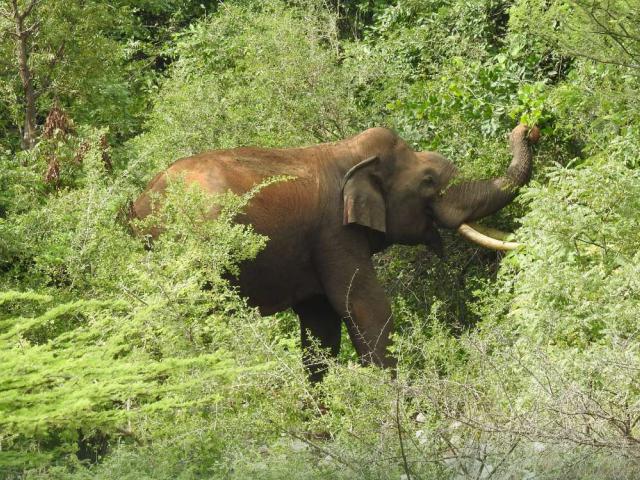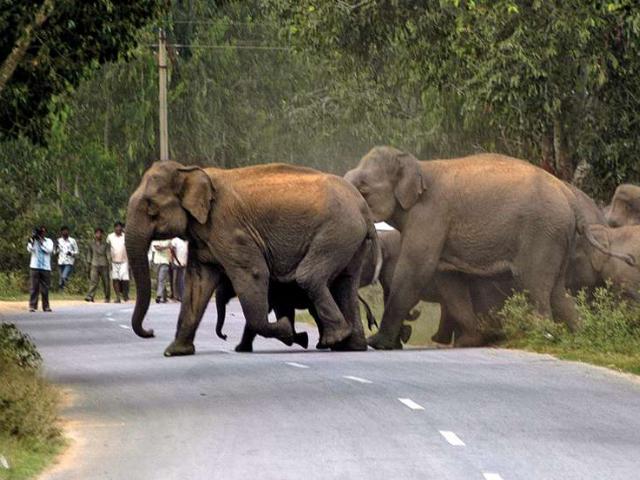The ElephantWhisperer- the Oscar winning short documentary - may have touched
the hearts of millions as it narrated the story of the two calves and the
animal loving couple, a large number of elephant calves are actually not lucky
enough to get such affection and compassion. As the great elephant
migration continues from east to west across India, the real-life plight
of the pachyderm is different from the reel- life love, often portrayed in the
movies. Let's pause and understand why ,amidst squeezing habitat, food and fodder shortage, the elephant in
India is more endangered than the highly protected tiger. These gentle giants
need more space and food as compared to the big cat. 100 Elephants Die Every Year

The
ever increasing quest for land by a growing human population throughout the
Indian elephant’s habitat is leaving a very little room for the “
intelligent beast” . The situation is further aggravated by Illegal encroachment
into protected areas and clearing of forests for linear development works
including roads. This is causing a great damage to the
already fragmented forest leading to a habitat loss. “
Habitat loss not only leaves elephants without reliable food sources and
shelter, it can also cause them to be confined to isolated populations that
cannot follow ancient migratory routes or mix with other herds”,
said the world wildlife fund- India (WWF-India) . India has 32 elephant reserves
in 14 states. But studies have shown that only 30 % of the country’s wild
elephants live in large and contiguous forests, while the rest are distributed
across fragmented landscapes that have shrunk amid growing human activities,
including cultivation. With the expansion of cultivated land along forest
boundaries, experts say, elephants are increasingly being drawn to forage for
crops such as maize, millets, paddy, sugarcane, and vegetables. In the last
five years, India lost 494 elephants to train accidents, electrocution,
poaching and poisoning, the parliament was informed in March 2023.
Also read: The Great Elephant Migration: Can MP Chattisgarh join hands to Welcome the Jumbo ?
Responding
to a question in the Lok Sabha, the environment ministry said electrocution
through contact with power transmission lines accounted for 348 elephant deaths
followed by train accidents (80), poaching (41) and poisoning (25) between
2017-18 and 2021-22. Experts believe that the number may appear small (494
deaths) against a population of nearly 30,000 wild elephants, such deaths could
disrupt herd dynamics and further increase the risk of human-elephant conflicts
(HEC) . However, the number of calves’ deaths is not known. The
loss of an older elephant in a herd is like the death of an elderly human in
some “This is loss of experience for the others in the herd,” , a member of the
elephant cell at the Wildlife Institute of India said . In the absence of older
elephants, the younger ones could stray into human-dominated landscapes leading
to HEC, experts said.
The Great Elephant Migration

Shrinking habitat, food and fodder shortage led to a huge migration of elephants in India. Following their ancient routes, they migrate from one jungle to another. As the landscape and climate changed, so did the animals. The New Scientist writes - Although they originated in Africa about 45 million years ago, the ancestors of modern elephants made several intercontinental treks during periods of low sea level. The earliest migration out of Africa was some 22 million years ago. Then, between 11.5 and 7 million years ago, elephantoids migrated back to Africa in two or three waves. Mammoths and the ancestors of the present-day Asian elephant probably evolved in Africa between 4 and 5 million years ago, and began migrating back into Eurasia two million years after that. Fast forward, the Asian elephant continues to look for new territories in the need of food and shelter. Nitin Sekar, WWF-India’s national lead for elephant conservation, explains what’s behind human-elephant conflict in Assam. And this theory is applicable across the country. He said, “ Elephants move out of remaining forest patches and cross into human-dominated areas due to two factors he describes as “push” and “pull.” With deforestation reducing their habitat by half within a short period of time, elephants have been left with few options but to enter villages and tea plantations bordering forests. This is the push factor. The pull factor is when elephants are drawn to food that’s more appealing than their forest fare—rice grains in agricultural fields or vegetables and legumes in kitchen gardens.
In the early 1900s, a steep decline in the number of Asian elephants was observed in the central parts of India, possibly due to anthropogenic activities. A few decades later, elephants that would erstwhile journey through Jharkhand and Odisha began to establish a new range in the Chhattisgarh region, writes Wildlife SOS, a conservation non -profit organization in India. The estimated number of elephants in Chattisgarh has crossed 300 marks. Their migration through dense forests often resulted in encounters with humans. This impacted both species adversely. From Chattisgarh they have entered Madhya Pradesh and a sizable number have settled down Bandhavgarh tiger reserve (50) and Sanjay Dubri national park (10) .They have been using Sanjay Dubri National park as a transit route to enter Madhya Pradesh. Elephants have also reached Kanha national park and from there they can travel to Pench tiger reserve and then to Satpuda tiger reserve in Hoshangabah , said Mridul Pathak, former director of Bandhavgarh national park.
Poaching On The Rise

“As
South Asia’s population explodes, elephants are getting squeezed into smaller
areas leading to major conflicts; we need to champion solutions that help both
elephants and people.” Said Dr. Barney Long ,Asian Species Expert. This
elephantine crisis of migration is also leading to the killing of
the animal. Indian elephants may spend up to 19 hours a day
feeding and they can produce about 220 pounds of dung per day while wandering
over an area that can cover up to 125 square miles. They feed mainly on grasses,
but large amounts of tree bark, roots, leaves and small stems are also eaten.
And when they don’t get it in the jungle, they move out to the neighbouring
villages foraging. Elephants are large and destructive animals and small
farmers can lose their entire livelihood overnight from an elephant raid. They
have also caused millions of dollars of damage to large agricultural
operations. As a result of their destructive raids, elephants are often killed
in retaliation. In recent years, human-elephant conflict has intensified.
Crops have been destroyed and people killed, which has led to elephants being
killed in retaliation. Government figures indicate that, on average, around 500
people and 100 elephants are killed each year in India because of human-elephant
conflict. This is happening now across the country . Even in
places like MP and Chattisgarh where they are expanding their base,
a number of incidents of retaliatory killing are reported.
Also read: More Questions On Cheetah Project in Kuno
WWF said that
Poaching rates are currently increasing because the Asian middle class fuel
demand despite the fact that there is a worldwide ban on ivory trade. Asian
elephants are poached for their ivory tusks, but unlike their African cousins
only male Asian elephants have tusks. Every poaching event further skews the
sex ratio which constrains breeding rates for the species. There are an
estimated 27,312 elephants, or nearly 55% of the species’ global population, as
of the 2017 census. They can be found in India’s 32 elephant reserves, which
are dispersed among ten elephant landscapes and 65,270 square kilometres of
forested areas in northeast, central, northwest, and south India. However,
unless the elephant reserve is located inside an already protected Reserve
Forest or the Protected Area network, these reserve areas are not just for
elephants. Elephant reserves in India are not legally protected ecosystems .
Though Karnataka has 25 % of India’s elephant population , an
estimated 40% of Indian elephants and nearly 10% of the total population of
wild Asian elephants reside within a 15,500 square mile area in the
northeastern states of Assam and Arunachal Pradesh. WWF supports human-elephant
conflict mitigation, biodiversity conservation, and awareness-building among
local communities in two elephant habitats in the Eastern Himalayas, the North
Bank Landscape and the Kaziranga Karbi-Anglong Landscape, and in the Nilgiris
Eastern Ghats Landscape in South India. The states of Assam and Arunachal
Pradesh also witnessed 812 human and 314 elephant fatalities between 2011 and
2021, according to WWF-India.
By Deshdeep Saxena
Representative Images: Courtsey TRUMPET, WII , TRAFFIC





Comments
Post a Comment